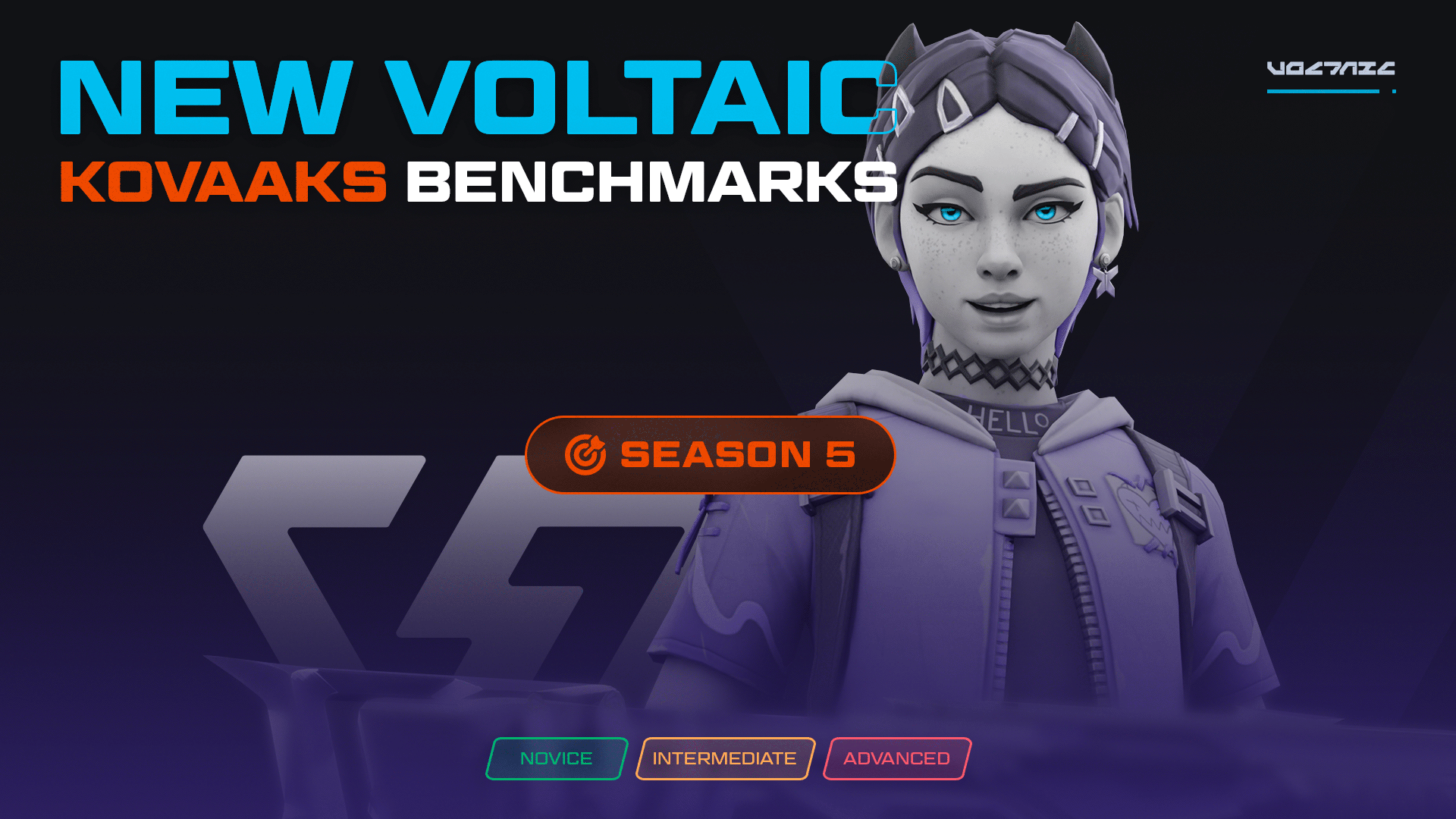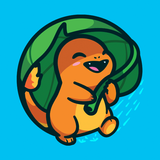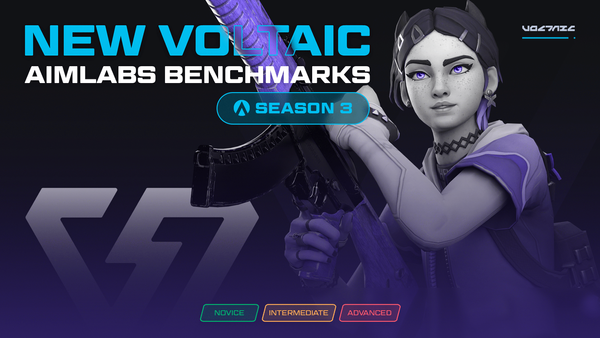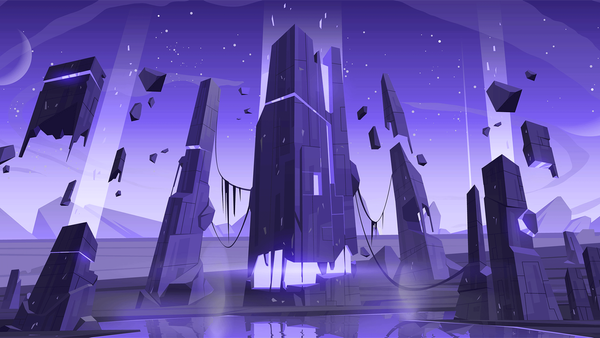Announcing the Voltaic Season 5 Aiming Benchmarks BETA for KovaaKs!

We're thrilled to announce the long-awaited Season 5 Aim Benchmarks for KovaaKs. The same tool from back in 2019 that you've been using to assess your aim for any FPS game, reimagined, allowing you to train even better and more motivated than ever. Similar to previous seasons you will be able to test your skills at Novice, Intermediate, and Advanced levels, so you get a clear indication of your skill while simultaneously being motivated to hone all your aiming techniques.
Similar to Aimlabs S3, we've categorized the scenarios into the core aiming principles: Clicking, Tracking, and Target Switching. Each category is further divided into subcategories to isolate specific techniques necessary for proficiency. This season, we're introducing a third "hybrid" category for each main skill (linear, control, stability), bridging traditional subcategory gaps to offer a more comprehensive training and benchmarking experience.
Keep in mind that while our benchmarks measure your raw aiming abilities, they represent just one piece of the puzzle for in-game performance. Use them as a supplementary tool to enhance your training routine and improve your foundational mouse control. Pair your aiming practice with essential game-specific skills like game sense and movement in your favorite FPS.
Lastly, as this is the first release of this project, some scenario bugs may arise, and the Score Requirements may be adjusted as we gather more data from the community. If you encounter any issues, we encourage you to report them!
Here's an overview of everything Season 5 (courtesy of Tammas):
Overall Changes
Reload Mechanic for Clicking scenarios 🔃
In previous seasons we have used both a reload mechanic, and a square root accuracy scoring mechanic for clicking scenarios. In Season 5 one scenario of each clicking category uses square root accuracy, while the other uses a modified reload system. In this system you start with 100 ammo in a clip, however each shot fired uses a large amount of this, with a successful hit restoring more ammo that what was used. For example, on "VT ww5t Intermediate S5" it costs 30 ammo to shoot, and a hit refunds 37 ammo. This means that missing a shot costs 30% of your ammo, and hitting a shot restores up to 7% of your ammo. As a result, for each miss on this scenario you would have to hit 4-5 shots to get the ammo back that you lost. The exact numbers used varies between the scenarios and each difficulty of those scenarios, however generally this is geared to force a higher average accuracy than a conventional reload scenario. To compensate, typically these scenarios allow a larger number of consecutive misses without having to reload from full ammo. Additionally, due to how KovaaK's works, a shot can only use as much ammo as the gun has left in the magazine. So, in situations where a miss would result in a reload, a hit will give enough ammo that the next shot can never be at risk of reloading. This is to say that at least two consecutive misses is always required to trigger a reload.
Target Switching Field of View 🖼️
All the target switching scenarios in season 5 are designed from the ground up to work with 103 hfov (horizontal field of view). Using FOV (Field of View) values greater than 103 hfov is still allowed for submissions.
Minimizing Invisible walls 🫥
Where practical each scenario is designed to avoid the use of invisible walls. This was done to avoid having runs get ruined by targets colliding with invisible walls, as well as to avoid the general awkwardness of aiming at targets as they interact with invisible walls.
Addition of Parallel walls 🛣️
In a lot of the scenarios in season 5 there are walls that are oriented to be parallel to the view of the player. What this means is that these walls block the movement of targets without being able to obscure the target from vision, and they do so without the target’s distance affecting how far in the direction of the wall the target can travel. Essentially this defines a 1-dimensional limit to the movement of the target.
Wall Repel Tech 🥊
Some scenarios in season 5 use a form of the wall repel tech from the scenario ''Cloverrawcontrol'' and ''froghouse'', where there are targets out of view that are repeatedly using a knockback ability. This is done to apply a consistent force pushing the target away from walls whenever it gets close to one.
Ramp Texture 🛹
Some scenarios in season 5 include surfaces marked to use the often-unused ramp texture, many of these are indicators for invisible walls, or parallel walls. You may need to adjust your visual theme to have an appropriate ramp texture for these to show well or look good.
Target Collision Disabled 👻
All scenarios in season 5 with multiple targets have collision disabled, this means that the targets are incapable of colliding with each other and will instead phase through each other.
Gauntlet Scenario Changes 🦾
A few of the tracking scenarios in season 5 are Gauntlet style scenarios with multiple targets in sequence. However, in these scenarios the duration of each target is fixed, with the target's health decaying automatically and the player being scored on the number of hits on each target before they decay. The gauntlet scenarios in season 5 are designed to not have any filler targets, instead each target is legitimately challenging in its own unique way.
Scenario Specific Changes
Pasu — Dynamic clicking scenario with diagonally moving targets ☄️
Acquire and time your clicks to multiple medium to small sized spheres as they traverse diagonally on a wall in front of the player.
This version of Pasu was designed to fix a few flaws in previous versions of Pasu. One of those being a bug that causes targets to not be able to jump in mid-air until they have either bounced off the floor or another target. A work around for this was implemented in S5 so the scenario difficulty remains consistent over a challenge run. The other flaw that was addressed is the targets being awkward to aim at when they interact with the sides, roof, and floor. While this awkwardness might introduce a challenging aspect to the scenario, it also introduces unnecessary randomness which is suboptimal for benchmarking. To work around this a modified version of Wall repel tech was used to encourage the targets to steer clear of the walls. The scenario also uses square root accuracy to balance the tendency for Pasu to be a more spam heavy clicking scenario.
Popcorn — Dynamic clicking scenario with vertically leaping/arcing targets 🍿
Smoothly acquire and time your clicks to multiple small sized spheres as they leap and arc in front of the player.
Since season 5 has categories for linear and dynamic clicking scenarios part of the goal with popcorn was to focus on the distinction between these categories by tuning the scenario to focus more on reaction and less on smoothness. All the targets accelerate horizontally very little in the air and significantly faster on when grounded, and do not strictly pogo jump, instead often remaining grounded briefly. This was done to discourage following a single target in anticipation of it jumping. The targets all have the same jump velocity with jump height being controlled by varying gravity. This was done so low jumping targets are in the air for longer, and high jumping targets have less abrupt acceleration. The lower gravity higher jumping targets also have higher strafe speed, so the difficulty of each target is fairly consistent. The scenario is also within a sub 180-degree region in front of the player to prevent needing to reset mouse position frequently and to reduce spawn RNG. Targets will bounce off the sides when going all the way left or right, so it is encouraged to prioritize targets closer to the middle of the arena. Uses a fairly lenient reload system by Popcorn standards as to not excessively discourage pacing.
1wxts — Static clicking scenario with small targets 🔴
Acquire, smoothly flick and micro-adjust when necessary to multiple small static targets.
Targets have a limited spawn region similar to 1w2ts perfected, spawn points are organized in a diamond pattern so that nearby spawns are more likely to be diagonally oriented, there is also no variation in depth of target spawns. Low target count and on the smaller side for small static targets to minimise pathing and to increase focus on pure static technique. Uses square root accuracy scoring so every shot matters.
ww5t — Static clicking scenarios with medium targets on a wide wall 🧱
Acquire, smoothly flick and micro-adjust when necessary to multiple small to medium targets on a wide wall.
This scenario is similar to Multiclick from season 4 however has significantly less variation in target size and a wider spawn region. This exceptionally wide spawn region was added to discourage the use of very low sensitivities. The spawn region is also curved so the target size remains consistent. The somewhat high target count is to minimise situations where there are no targets left in view. This is intended to lean a bit more towards being a speed clicking scenario, so the targets are more moderate in size and reload is used instead of square root accuracy.
Frogtagon — Linear Clicking scenario with frogs moving in multiple linear directions 🐸
Acquire, smoothly approach and time your clicks on multiple spherical frogs.
As a linear clicking scenario the targets in Frogtagon perform predictable strafes in straight lines. Targets will spawn strafing at a fixed angle and will reverse direction when colliding with a wall. Targets are trapped inside an octagon with distinct edges to make bounce timing intuitive. This linear scenario is intended to be more speed focused and as such the targets are slightly larger and reload is used instead of square root accuracy.
Floating Heads — Linear Clicking scenario with floating heads strafing in long horizontal directions with subtle vertical movements ☠️
Acquire, smoothly approach and time your clicks on multiple spherical heads that strafe horizontally, slowly adjust directions, and subtly move up and down.
Unlike standard Floating Heads, the targets in this version float up and down while strafing, although, the movement is still very easy to read. The map consists of three horizontal chambers layered on top of each other to increase the variety of vertical spawns while facilitating the target movement used. This scenario focuses more on precision, so the targets are fairly small and square root accuracy is used.
PGT (Precise Goated Tracking) — Precise Tracking scenario with goats not jumping, but arcing 🐐
Smoothly approach, acquire, and track small spherical goats that arc in front of the player.
This is Precision Goated Tracking, not Popcorn, so all the targets do not jump. Part of the goal when designing this scenario was to avoid having the targets jump at/over the player, and to avoid the targets travelling at excessively steep trajectories. This was done as previous scenarios in this style are often reduced to focusing on an excessively niche form/context of aim. The map for this scenario features a slanted floor, the goal of which was to create a varying jump starting and end height to encourage players to focus more on reading the target's movement and less on finding the rhythm of how a target jumps.
Snake Track — Precise Tracking scenario that involves a thin snake with long strafes at accelerated/decelerated speed 🐍
Smoothly track a thin cylindrical shaped snake that strafes horizontally.
The goal of snake track as a concept is to have a thin long strafing target that is constantly accelerating or decelerating in order to avoid having the scenario simply be a centering scenario where you try to match the target's speed perfectly. This version of snake track specifically features a dish shaped arena, which is slanted in the harder versions. This was done to add subtle vertical movement reading without overshadowing the general horizontal reading focus.
Aether — Reactive Tracking scenario with both vertical and horizontal strafes ☁️
Track a spherical target that strafes both vertically and horizontally in the air at varied speeds with fast direction changes to emphasize reactivity.
This is an aerial tracking scenario, so essentially Air. The point of calling this scenario "Aether" instead was to avoid tying this scenario to what people expect Air to be. Generally, the scenario has a greater variety of target movement styles than typical Air variants.
Ground — Reactive Tracking scenario with horizontal strafes ⛰️
Track a cylindrical target that strafes exclusively horizontally in all directions on the ground at varied speeds with fast direction changes to emphasize reactivity.
Like with Aether this scenario is not supposed to be "just another plaza", although the distinction here is a bit more subtle. Inspired by plink plaza.
Raw Control — Control Tracking scenario with strafes on the XYZ-axis using varying strafe distances ✏️
Track a spherical target that strafes on the XYZ-axis at varying speeds with smoother direction changes.
The scenario was designed to focus on XYZ tracking with a target that doesn't collide with the walls. Inspired by ''cloverrawcontrol'' and ''whisphere''.
Controlsphere — Control Tracking scenario with aerial (vertical/horizontal) strafes with smooth direction changes 🦋
Track a spherical target that strafes vertically and horizontally with smoother direction changes emphasizing control over reactivity.
Similar goal as Raw control but the wall avoidance is achieved by having the target in a circular arena. Wall repel tech is still used to avoid collisions with the roof and floor. This scenario focuses less on forward and backwards movement and also has more conventional strafing behavior.
DotTS — Speed Switching scenario with static dots 🟣
Hold down left click during the entirety of the scenario - Acquire, smoothly flick, and micro-adjust to multiple small to medium dots on a wide view.
With an increased focus on the distinction between the various target switching scenarios the opportunity was taken to have one of the speed switching scenarios be a static target switching scenario. The time to kill here is notably longer than Pokeball scenarios.
EddieTS — Speed Switching scenario with diagonally moving greebles 🦔
Acquire, smoothly flick, micro-adjust and briefly track multiple small to medium greebles at varying distances.
Replacement for PsalmTS, with a focus on more regular and predictable movement, to lean into the speed target switching design.
DriftTS — Evasive Switching scenario with drifting and accelerating targets 🏎️
Acquire, smoothly flick, micro-adjust and briefly track multiple small to medium spheres at varying distances.
The goal of DriftTS was to focus on micro correction after target acquisition. So while the targets have short strafe times, they also have their acceleration and speed tuned so the bots are constantly either accelerating or decelerating to force a higher focus on tracking and less on rhythm. Vertical movement is minor here to focus on horizontal tracking. They are also generally harder to track than conventional evasive target switching scenarios.
FlyTS — Evasive Switching scenario with XYZ movement 🕊️
Acquire, smoothly flick, micro-adjust and briefly track multiple small to medium spheres at varying distances that strafe on the XYZ-axis.
FlyTS has a heavier focus on XYZ movement with a fairly high TTK, with the bots strafing is less conventional and predictable directions and patterns.
ControlTS — Stability Switching scenario with gently jumping targets🕹️
Acquire, smoothly flick, micro-adjust and briefly track multiple small spheres at varying distances that jump slightly.
Similar to DriftTS, although with a greater focus on precision, so the targets are slower and smaller, and the arena is narrower to minimize flick distances.
PentaBounce — Stability Switching scenario with targets that bounce off a pentagon 🏓
Acquire, smoothly flick, micro-adjust and briefly track multiple small to medium spheres that ricochet around the inside of a pentagon.
The goal with Pentabounce was to make a smoothness target switching scenario with predictable movement in straight lines at varying angles. To achieve this the targets bounce around with minimal gravity in a pentagonal arena that has clearly defined edges to make reading bounce timing intuitive. The targets preserve their momentum on bounce unlike with frogtagon.
Webapp for KovaaKs S5 🖥️
The webapp for KovaaKs S5 is in development and is expected to release early 2025. In the meantime we have provided a temporary spreedsheet to track scores, and play the Season early. Leaderboards for the benchmarks will be released later hopefully, as it may be limited by the API.
Rank Reset & Rank Applications ⚔️
In an earlier announcement we mentioned that rank resets were going to happen a week after the Aimlabs S3 Beta was out, however we decided to delay this until KovaaKs S5 was finished:
- In one week from now we will reset all ranks, meaning everyone will go into the new season in 2024-2025 with a fresh new rank.
- Rank Applications for KovaaKs S4 and Aimlabs S2 will be closing in one week from now.
- Rank Applications for Aimlabs S3 will be opening shortly after the rank reset happens (depending on when the bot development is finished for it).
- Rank Applications for KovaaKs S5 have no ETA, as we need the time to collect data within the first weeks of the benchmarks to make any needed adjustments and balance changes. However, we will do our best to make the changes as soon as possible.
- There will be a follow-up announcement where we will communicate when the Rank Reset will happen.





